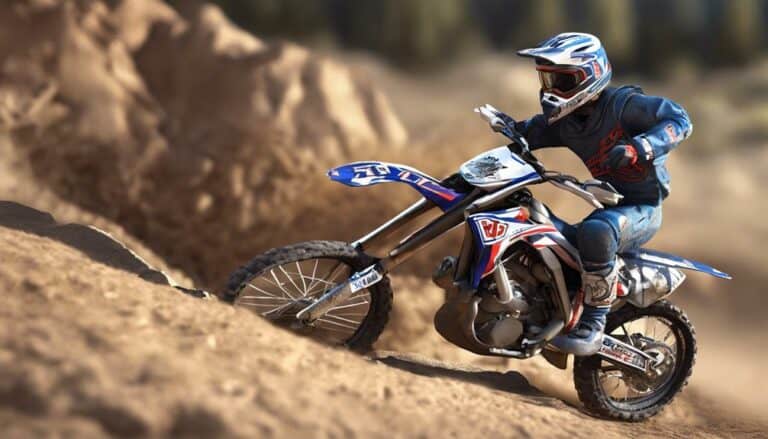In motocross, focus on responsiveness and agility with stiffer springs and damping. Trail riding prioritizes comfort with softer settings and fine-tuning for rough terrain. Motocross suspension is intentionally stiffer, while trail bikes are softer for comfort. Adjust sag, compression, and rebound accordingly. Strike a balance between comfort and performance, employing the right setup for each terrain. Customize suspension to meet specific riding demands. Find the sweet spot between comfort and handling. Explore how suspension adjustments can elevate your riding experience.
Key Takeaways
- Motocross focuses on responsiveness and agility with stiffer settings.
- Trail riding prioritizes comfort and compliance with softer suspension adjustments.
- Motocross suspensions are firmer for aggressive riding on prepared terrain.
- Trail bike suspensions are softer for improved comfort and traction.
- Suspension setups are tailored to meet the specific demands of each riding style.
Motocross Suspension Adjustment Priorities
When adjusting suspension for motocross, prioritize responsiveness and agility to enhance handling for high jumps and sharp turns on groomed tracks.
Motocross suspension is designed to cater to the demands of aggressive riding on well-prepared surfaces. By focusing on responsiveness, the suspension system allows for quick and precise adjustments to tackle obstacles like high jumps with ease.
Agility plays an important role in maneuvering sharp turns, ensuring the bike can change direction swiftly and efficiently on groomed tracks. To achieve these characteristics, motocross suspension setups often feature stiffer springs and firmer damping, emphasizing performance over comfort.
Fine-tuning the suspension for aggressive riding conditions optimizes the bike's performance in controlled track environments, enhancing the overall handling and stability. The primary goal of motocross suspension adjustment is to provide riders with the confidence to push their limits, knowing that the bike can deliver the responsiveness and agility needed for high-level performance on groomed tracks.
Trail Riding Suspension Setup Considerations
To excel in trail riding, your suspension setup must prioritize comfort and compliance over aggressive performance, ensuring ideal handling across varied terrain conditions.
When setting up your suspension for trail riding, consider softening the settings to improve comfort and traction over rough surfaces. Adjusting damping is vital for slower speeds encountered on trails, helping the suspension to absorb impacts effectively and maintain traction. Fine-tuning sag settings is also essential to achieve perfect balance and stability, especially when tackling challenging trail obstacles.
Additionally, adding protective accessories like skid plates and handguards can complement your trail riding suspension setup, safeguarding your bike from potential damage and allowing you to ride with confidence.
Differences in Suspension Stiffness
Comparing motocross and trail bike suspensions reveals a distinct contrast in stiffness levels to cater to the specific demands of each riding environment. Motocross suspension is intentionally stiffer to withstand the rigors of big jumps, sharp turns, and high-speed maneuvers on the track. This higher stiffness prioritizes performance and responsiveness, important for competitive racing where precision is key.
On the other hand, trail bike suspension is softer to enhance comfort and absorb impact while traversing varied terrain during leisurely rides. The softer suspension setup offers a smoother experience, making it more suitable for long-distance trail riding where rider comfort is a significant factor.
Adjusting suspension stiffness plays an important role in optimizing handling and control based on the riding environment. For motocross, firmer suspension settings are typically preferred to enhance bike stability and agility during aggressive maneuvers. In contrast, softer suspension settings are favored for trail riding to improve comfort and adaptability to changing terrains, prioritizing a more relaxed and enjoyable riding experience.
The differences in suspension stiffness between motocross and trail riding underscore the importance of tailoring the suspension setup to meet the specific demands of each riding discipline.
Adjusting for Terrain Variability
In adjusting suspension settings for terrain variability, focus on optimizing sag settings to enhance handling over rough terrain and obstacles effectively. When riding trail bikes, softer suspension is key to absorbing bumps and providing comfort over varying terrains.
To tackle high speeds and maneuver big jumps, adjustments to compression and rebound are essential. Here are some key points to ponder:
- Softer Suspension: Trail bikes require softer suspension settings to absorb bumps and provide comfort over varying terrains.
- Compression and Rebound: Adjust the compression and rebound settings to enhance handling characteristics for trail riding.
- Optimizing Sag Settings: Focus on optimizing sag settings to enhance handling over rough terrain and obstacles effectively.
- Handling Big Jumps: Make sure your suspension settings are adjusted to handle the impact of big jumps effectively.
- High Speeds: Take into account the impact of high speeds on your suspension settings and make necessary adjustments for peak performance.
Balancing Comfort and Performance
When considering suspension adjustments for motocross and trail riding, striking a balance between comfort and performance is essential for maximizing your riding experience.
For trail bikes, the suspension setup needs to cater to varying terrains while providing a comfortable ride. This means utilizing softer springs and damping settings that offer forgiveness over bumps and obstacles, enhancing the bike's handling capabilities. By prioritizing comfort without sacrificing performance, trail riders can navigate through rough terrain with better control and reduced fatigue.
On the other hand, motocross suspension is tailored for high-performance maneuvers on groomed tracks, emphasizing responsiveness and agility. Stiffer springs and firmer damping are employed to handle the demands of sharp turns and high jumps, sacrificing some comfort for enhanced performance.
When adjusting suspension settings, trail riders should fine-tune their setup to strike the right balance between comfort and performance based on the terrain they'll encounter, ensuring top-notch handling and ride quality throughout their off-road adventures.
Conclusion
So, wrapping up, when it comes to suspension adjustment techniques for motocross versus trail riding, it's all about finding the perfect balance between comfort and performance.
By understanding the priorities for each type of riding and considering factors like terrain variability and suspension stiffness, you can fine-tune your setup for peak performance on the track or trail.
Remember, it's all about making those subtle adjustments to enhance your riding experience.

